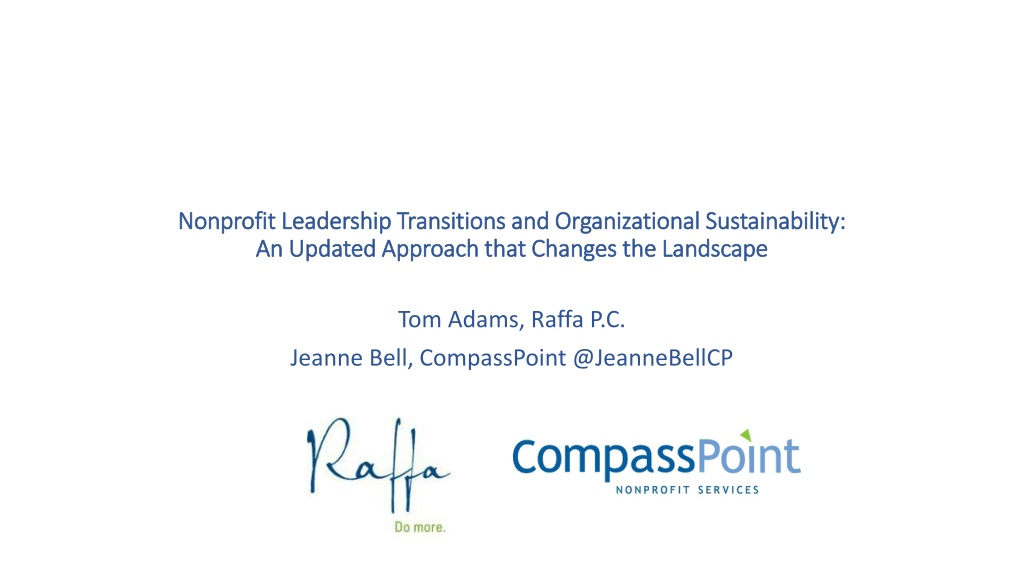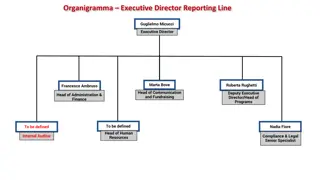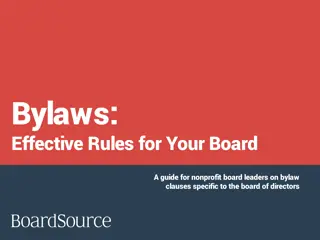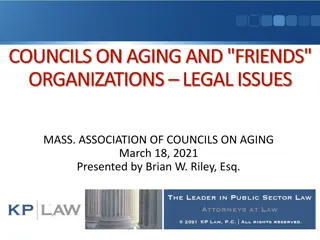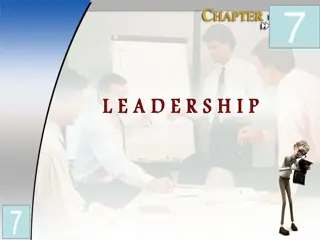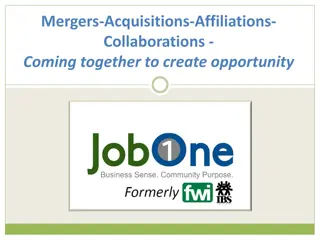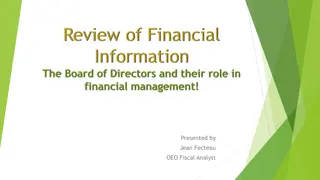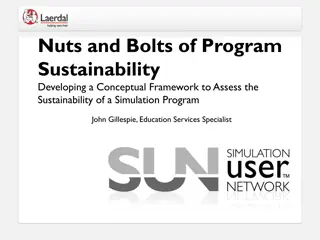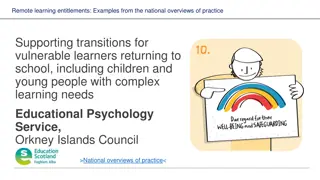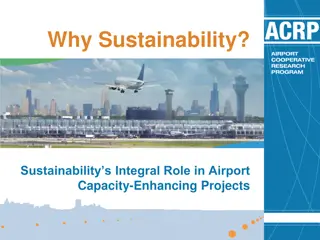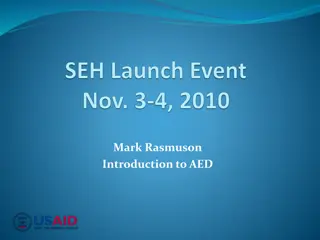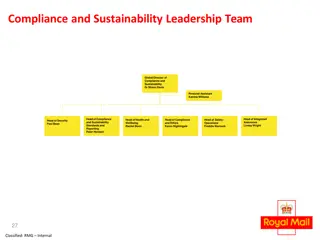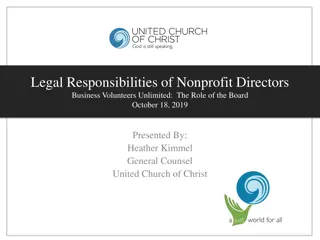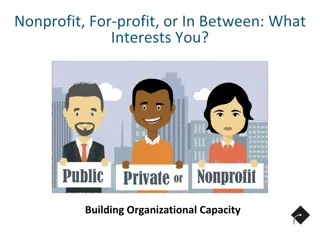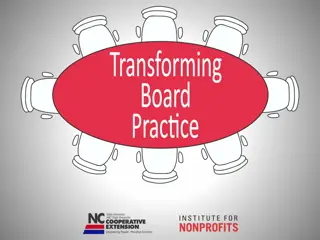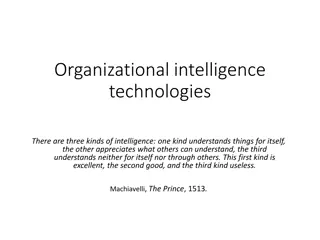Nonprofit Leadership Transitions for Organizational Sustainability: An Updated Approach
Explore the evolving landscape of nonprofit leadership transitions and organizational sustainability with a focus on the executive search and transition process. Learn about the importance of leader development, organizational sustainability, and how to navigate inevitable transitions in a changing environment. Discover key insights and strategies to enhance organizational capacity under new leadership.
Download Presentation

Please find below an Image/Link to download the presentation.
The content on the website is provided AS IS for your information and personal use only. It may not be sold, licensed, or shared on other websites without obtaining consent from the author. Download presentation by click this link. If you encounter any issues during the download, it is possible that the publisher has removed the file from their server.
E N D
Presentation Transcript
Nonprofit Leadership Transitions and Organizational Sustainability: Nonprofit Leadership Transitions and Organizational Sustainability: An Updated Approach that Changes the Landscape An Updated Approach that Changes the Landscape Tom Adams, Raffa P.C. Jeanne Bell, CompassPoint @JeanneBellCP
About this project: About this project: Why pause and reflect on ETM? Why pause and reflect on ETM? Why now for Raffa? Why now for CompassPoint? We need to both affirm and broaden our approach to the critical support organizations preparing for executive transition need, and challenge the sector on who leads and how. We thank the David & Lucille Packard Foundation and the Annie E. Casey Foundation for their generous support of this project. 2
CEO PROCESS OVERVIEW Search Search Prepare Prepare Onboard Executive Search and Transitio n Organize & Tailor the Process Launch the Search Launch the Search Onboard Onboard Gather Information Recruit Recruit Relate Relate Engage the Board Screen Screen Evaluate Evaluate Develop Profile & Search Plan Select Select Support Support Hire Hire An exceptional executive selected who fits the current and future leadership needs of the organization. Board-executive alignment on priorities, roles and performance measures. Board clarity and alignment about the four factors critical to the search and transition. OUTCOME: Increased capacity to deliver organization s mission under new leadership. Page 3
Executive transition realities Executive transition realities 8-10% of organizations transition executives every year Major investment by national and regional foundations over past 20 years has reduced risks and increased gains for organizations facing transition; developed resources and a proven practice Central idea that there is a difference between an executive search and an executive transition The 2008-2009 recession and the current threat to government funding make clear the need for a broader approach connecting organizational and leader transitions There is an opportunity to make attention to leader development, organizational sustainability, and inevitable transitions part of the culture of organizations and sectors 4
The clear case for transition support The clear case for transition support Challenging for Incoming Leaders Inheriting Financial Challenge 10% 27% 30% 60% 63% Smooth or Fairly Smooth Somewhat or Very Challenging Strong Moderately Healthy Weak or In Crisis data from 885 executives nationally collected by CompassPoint in partnership with Blue Avocado 5
What do we mean by ETM and allied services? What do we mean by ETM and allied services? Sustainability Planning Succession Planning High Mission Impact Executive Search and Transition 6
We need to work on two, intersecting fronts We need to work on two, intersecting fronts Engage ETM and allied services broadly Promote leaders of color/leaders with an equity analysis Transform Sector Leadership Strengthen Organizatons Change the ways we lead to reflect our values and intended social change 7
Who leads? Who leads? 2001 Daring to Lead 2015 Transition Research 21% 25% 75% 79% People of Color white People of Color white 8
Where do leaders come from? Where do leaders come from? 2001 Daring to Lead 2015 Transition Research 32% 36% 64% 68% Developed Inside Hired from Outside Developed Inside Hired from Outside 9
Changing how we lead: Changing how we lead: Insights from Executives Sharing Power Insights from Executives Sharing Power We re different people from the folks who have informed the thinking about organizational leadership and management over the last 100 years. We come at it differently. . D. Nipper, Rockwood We were really, really clear that MAG needed to shift its internal practice behavior and culture to reflect the world that we are contributing to making. M. Sloan-Perry, MAG It s not fewer hours, but it is less pressure and isolation. I can t even say how different it is. It s dramatically different, which is a big sustainability issue for me. F. Kunreuther, Building Movement Project 10
We need to work on two, intersecting fronts We need to work on two, intersecting fronts Engage ETM and allied services broadly Promote leaders of color/leaders with an equity analysis Transform Sector Leadership Strengthen Organizatons Change the ways we lead to reflect our values and intended social change 11
Read further and engage online Read further and engage online The Evolution of Executive Transition and Allied Practices: A Call for Service Integration by Tom Adams, Director at Raffa, P.C. https://www.raffa.com/successionandsustainability/documents/executivetransition report.pdf Will We Get There Hire by Hire? Reflections on Executive Leadership and Transition Data over 15 years by Jeanne Bell, Paola Cub as, Byron Johnson 5 Insights From Directors Sharing Power by Jeanne Bell, Paola Cub as, Byron Johnson https://www.compasspoint.org/RevisitingET 12
